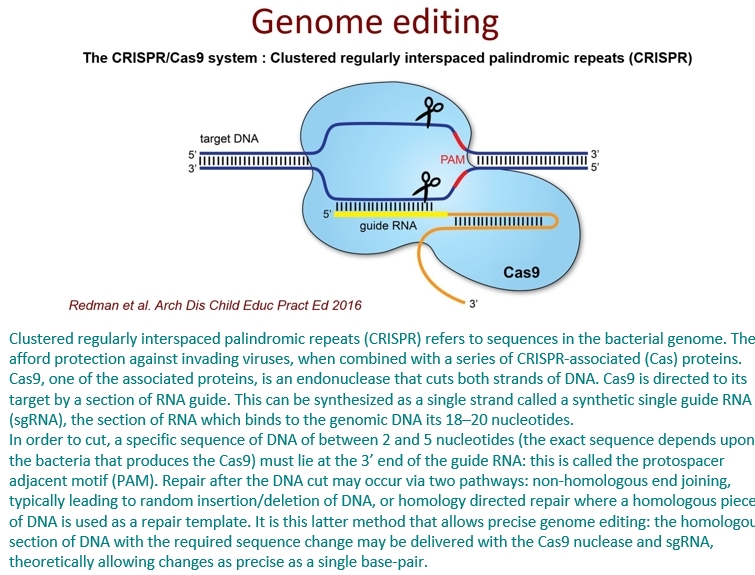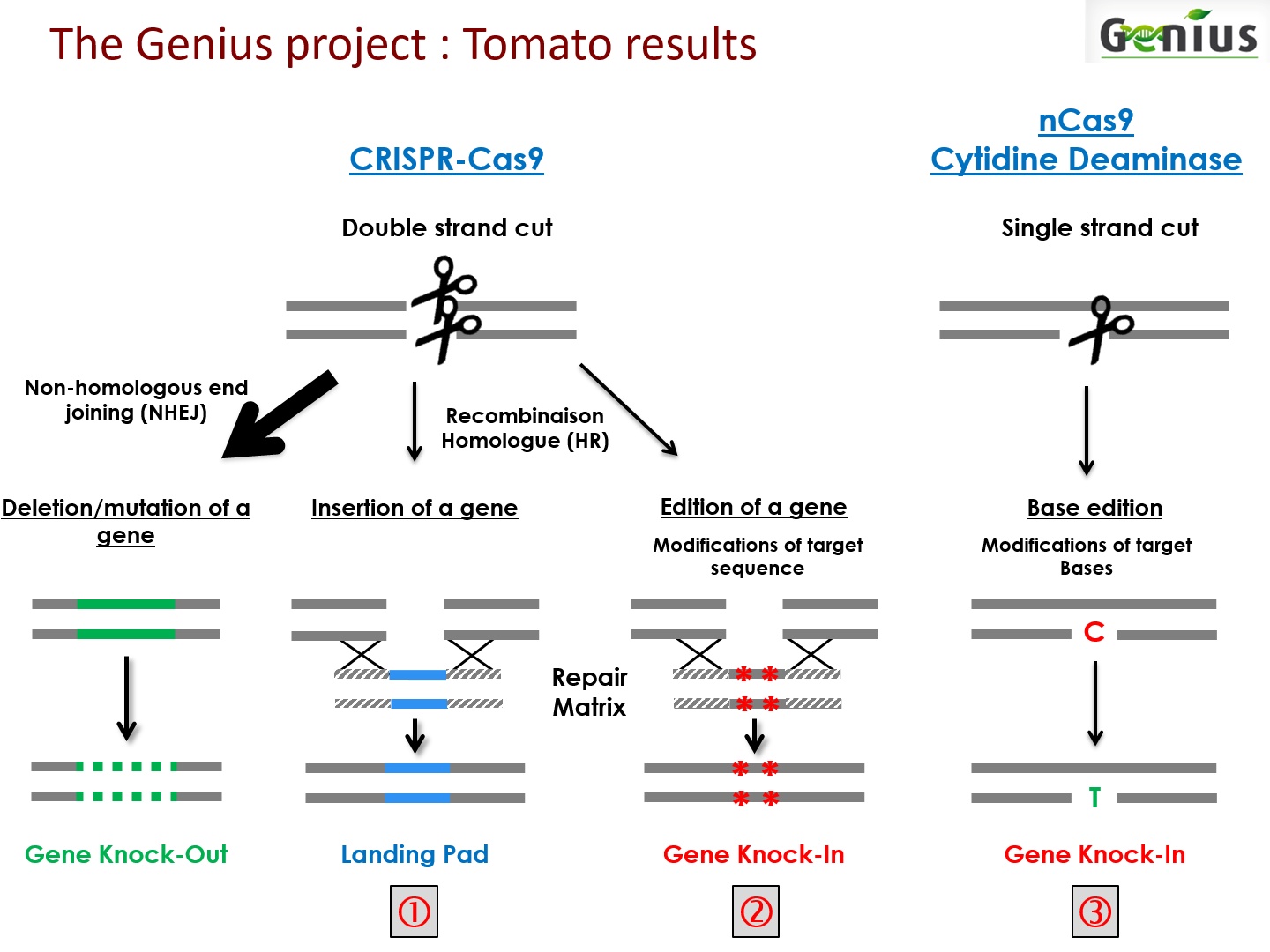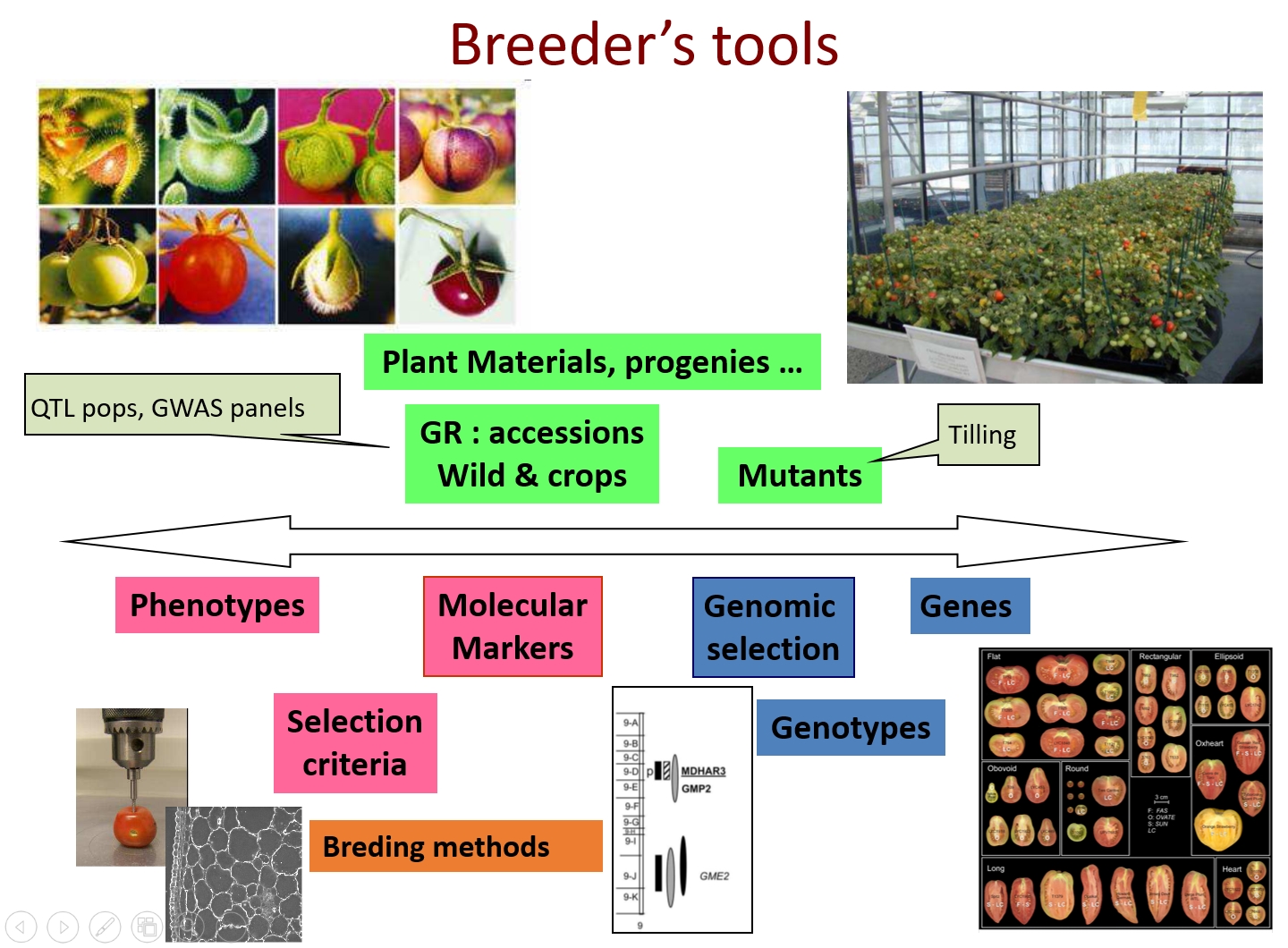Genomic selection, genome editing
"The progress achieved by these different techniques and the detailed knowledge of many SNPs have allowed researchers to think up a method for genome selection. In general, traditional selection consists in carrying out cross-breeding procedures, measuring the phenotype of descendants (in the hope of observing the occurrence of an interesting trait in the combination of parental characteristics), then to crossbreed again the most interesting individuals...
Thanks to marker-assisted selection, procedures can be carried out slightly faster, but the fields of investigation are very precise, and a small number of genes can be observed. With genomic selection, scientists use the information contained within the genome as a whole to design models that can help predict the phenotype ("traits") of a plant based on its genotype (the polymorphism of its DNA). It is then possible to carry out selection procedures simply on the basis of molecular markers and thanks to the wider information contained in the genome. As the price of genotyping is currently very low, it is more interesting and more efficient to proceed in this way, rather than using methods that require phenotyping and a prolonged experimentation stage. Experimentation is necessary and unavoidable at the beginning, but only for a given proportion of the population, providing the necessary information to accurately predict the phenotype of the population as a whole. In the end, it is also necessary to validate the phenotype of individuals that are judged more interesting on the basis of their genotype."

"Genome editing can be carried out using a method called CRISPR-Cas9, invented a few years ago, and based on the use of a protein – Cas9, an enzyme used by bacteria to protect themselves against viral aggression. Used as a way of entering, this enzyme acts like a pair of scissors, cutting into DNA and then repairing it. This cut – or genome editing – is carried out within specific sections that are "recognized" by a particular section of RNA (guide RNA).
This technique for gene editing using CRISPR represents a choice tool to improve the characteristics of cultivated plants, and there are many different ways of using this technology, according to the different modalities of cutting and repairing the complementary sequences in the base pairs that make up DNA strands.
The CRISPR system allows scientists to generate double-strand DNA cuts in the genome. These cuts can be repaired in two ways:
• non-homologous end joining (NHEJ); this is the most frequent technique and is close to traditional GMO methods, but it can lead to errors in the repairs. It can be used to efficiently generate a "knock-out" in a gene in order to render it nonfunctional. This type of approach can be interesting in the case of a gene with undesirable effects, like a sensitivity to a certain disease or to abiotic stress. The effects of this technique, which can be relatively brutal in comparison with derived methods, can nonetheless turn out to be fairly random.
• homology-directed repair (HR), a less frequent technique that can be used effectively by providing a repair template whose extremities present sections of homology with the target DNA. In this way, it is possible to achieve the following:
o the insertion of a gene, precisely positioned at the desired location (landing pad) on the genome. The gene is not "broken" but modified by the alteration of the sequence of amino-acids that make up the protein. In this way, regulation is much more precise than in the case of a knock-out.
o the editing of a gene, an interesting technique by which it is possible to insert a repair template with small but very precise modifications to the sequence. This template becomes a model/dressing for the repair. With this technique (called "knock-in"), it is possible to introduce small modifications in the genome."
"Although gene editing by homologous DNA recombination is particularly suitable for improving cultivated plants, the technique remains difficult to control, and only gives a low percentage of success in terms of the desired insertions. In order to compensate for these limitations, new tools derived from standard CRISPR have been developed, using slightly different approaches in which the Cas9 enzyme is partially inactivated so as to only cut one of the two strands of DNA and allow the replacement of one base by another. This means that the gene can be edited at the level of its bases, a tool that is very efficient to carry out precise and predictable modifications at the highly detailed level of a specific base. This method, which is precise, targeted, simple and economic, also limits the emergence of undesirable mutations that can appear with the classic CRISPR method."
"Researchers have developed these three technologies for tomatoes, leading to the possibility of reliable results for all kinds of genes, over a period of only six months. Several research reports have been published, notably regarding the development of varieties that are resistant to bacterial speck, to TYLC and to powdery mildew, using CRISPR methods. One very interesting aspect of genome editing is the possibility that the method offers of working not only on a single mutation at a time, but on several mutations simultaneously. Work carried out in 2018 on the re-domestication of Solanum pimpinellifolium by targeting six genes simultaneously (plant growth, fruit growth, oblong shape, fruit weight, number of fruits, lycopene content of the fruit) have shown that genome editing can result in plants that produce ten times more fruit, with fruit that is three times bigger and with a lycopene content that is 500 times higher."
"It is nonetheless important to note that the success level of the CRISPR method is not absolute and logically decreases as the required level of precision and accuracy increases. Although the knockout of the gene is relatively easy to achieve, targeted replacement of a few nucleotides is more complex. This technology does not yet allow operators to easily carry out all kinds of replacements: some base to base conversions (adenine, thymine, cytosine and guanine) do not work.
Furthermore, one of the main points is that the method also requires precise knowledge of the genes to be modified. And despite the huge work already achieved, researchers have not yet identified all of the genes: each feature and each function can involve several dozen genes and, although the 35 000 genes (approximately) of the tomato have been identified, it is still not known in detail what their variations can cause in terms of field phenotypic expression. Researchers estimate that approximately one-third of them have as yet no known function, and that a lot of them take part in knock-on processes linked to regulation, but they are still ignorant of the effects (resistances, specific adaptations, etc.) that possible modifications could cause, at least until they have been studied in greater detail.
As for disease resistances, current research now has about fifty characterized genes to work with. With regard to the weight of the fruit, at least 30 important genes have been identified, among which only four have as yet been characterized. Concerning aroma, researchers have been able to identify about 10 genes, while for the shape of the fruit, which is a simple characteristic, four genes have been characterized, "explaining" approximately 95% of the shapes observed. Conversely, characteristics of resistance to saline stress, to hydric stress, to heat, etc., are very complex and involve a high number of genes, making it very difficult to identify and establish a hierarchy of the genes responsible for the reactions to different forms of stress."
"In order to understand the limitations of this method, it is essential to correctly comprehend the difference between a gene – the trait or the function for which it codes – and the fact that its modification can induce important or significant variations in the expression of this trait. The fact that a gene plays a role in a given function does not necessarily imply that its role is decisive in this function. So, researchers need to determine which gene to target for its regulatory role as a limiting factor modifying a specific trait. In summary, researchers have acquired good knowledge of the genome with regard to resistances. As for the capacity of crops to adapt to external conditions, knowledge currently remains limited in terms of quantity, and needs to be fine-tuned for some of the already identified targets. In the field of quality, the criteria are extremely numerous: processes linked to sugar content, to acid content or to aroma have been well documented. However, regarding phenomena linked to viscosity, which is a vital parameter for the tomato processing industry, a lot of work remains to be done, particularly in the upstream sector at the physiological level, in order to better understand which parameters and processes are involved, before research can be carried out that could potentially focus on the genes responsible for the size of cells as well as for other characteristics that also remain to be determined.
Finally, the lycopene content of fruit is an area where knowledge of the genome is good. But there is still a major difficulty to be overcome in increasing this content in the flesh of the fruit, because most of the lycopene found in tomatoes is contained in the skin. Such an objective is difficult but not impossible to reach, and will require the construction of systems that involve a number of different regulators and need a high number of genes to be modified."
European legislation is inadequate
"Genome editing clearly appears as an highly interesting method for varietal improvement, but, according to a decision of the Court of Justice of the European Union, the technique is defined as the genetic modification of organisms, as in a "modification of the plant", despite the fact that the result of the operation is not a genetically modified organism, as no foreign input remains in the plant, and there is no resistance to an antibiotic or any full or partial sequence that is foreign to the original genome. For this reason, it seems legitimate to consider that this technology should be regulated by different rules than the ones that are used to govern "conventional" GMOs.
 Last year, the world of seed breeders and genetics engineers expressed its surprise and disappointment when the technology for genome editing was included in the framework for implementation of laws governing GMOs within the European community. So it will be very difficult and costly to obtain these materials in Europe, whereas in the United States and in a number of other countries, legislation does not apply to the technology used in obtaining the material, but to the final plant material obtained. In this context, a product can be considered as GMO and will therefore either be authorized or banned, while the method for obtaining the material does not come under the same type of restrictions."
Last year, the world of seed breeders and genetics engineers expressed its surprise and disappointment when the technology for genome editing was included in the framework for implementation of laws governing GMOs within the European community. So it will be very difficult and costly to obtain these materials in Europe, whereas in the United States and in a number of other countries, legislation does not apply to the technology used in obtaining the material, but to the final plant material obtained. In this context, a product can be considered as GMO and will therefore either be authorized or banned, while the method for obtaining the material does not come under the same type of restrictions."
For the time being, unless research demonstrates a complete natural dead-end – like a disease for which no natural resistance has been identified – for which the use of biotechnology would represent the only solution, a change in European legislation is unlikely. At the same time, there remains the issue of the capacity of scientists and of public authorities to identify a product stemming from CRISPR methods of genome editing. For Mathilde Causse, the difference is almost impossible to identify, given that "the modification may only apply to a single base among several million polymorphisms present within a variety," whereas traces of conventional genetic modification can be detected. This requirement of European law means that breeders will need to provide specific varieties intended for the European markets, which will never leave European territory, and it will therefore be imperative to ensure that no varieties are ever introduced from the USA, from China, from Australia or from other countries outside of the EU. Such partitioning of the industry at a worldwide level will unavoidably one day lead to the issues of how to control the flows of fresh produce (and maybe also processed products) as they move between countries with different legislations, and of the distortion in competition that will inevitably be induced by the delays imposed by political decisions on industrial seed-breeding operators...
Some additional information
Find out more about Mathilde Causse and her work:
Tools for seed-breeder
This article refers to the Tomato News Conference held in Avignon (Fr) on 16 and 17 May 2019, during which the "2019 Processed Tomato Yearbook" was distributed to attendees. A copy of this book can be purchased from this website (go to GET LISTED) or fill in and post the order form.
Source: Tomato News conference, Interview Mathilde Causse (INRA)




 Last year, the world of seed breeders and genetics engineers expressed its surprise and disappointment when the technology for genome editing was included in the framework for implementation of laws governing GMOs within the European community. So it will be very difficult and costly to obtain these materials in Europe, whereas in the United States and in a number of other countries, legislation does not apply to the technology used in obtaining the material, but to the final plant material obtained. In this context, a product can be considered as GMO and will therefore either be authorized or banned, while the method for obtaining the material does not come under the same type of restrictions."
Last year, the world of seed breeders and genetics engineers expressed its surprise and disappointment when the technology for genome editing was included in the framework for implementation of laws governing GMOs within the European community. So it will be very difficult and costly to obtain these materials in Europe, whereas in the United States and in a number of other countries, legislation does not apply to the technology used in obtaining the material, but to the final plant material obtained. In this context, a product can be considered as GMO and will therefore either be authorized or banned, while the method for obtaining the material does not come under the same type of restrictions."



























